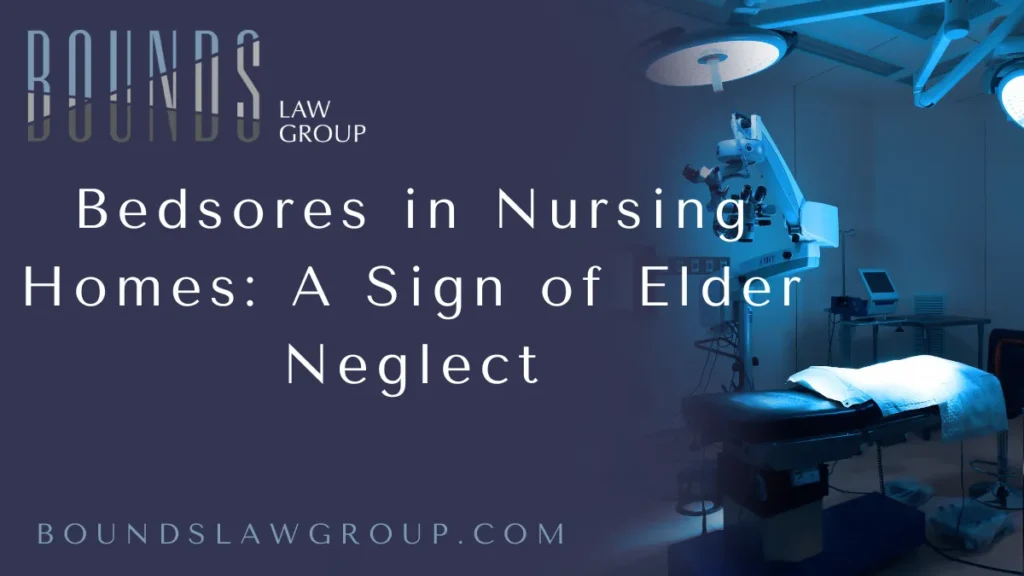
Nursing Home Bedsores | Bounds Law Group
When families entrust the care of their elderly loved ones to a nursing home, they expect safety, respect, and attentive medical supervision. However, bedsores—also known as pressure ulcers or decubitus ulcers—are one of the most alarming indicators of elder neglect. If your loved one has suffered from these injuries, a nursing home bedsore lawsuit may be the most powerful tool to demand justice and compensation.
At Bounds Law Group, we are committed to holding negligent facilities accountable. Read on to learn more about your legal rights and how you can take action today.
Contact us now at 877-644-5122 or complete the free case evaluation form for expert legal assistance.
What Are Bedsores and Why Do They Indicate Neglect?
Bedsores develop when sustained pressure restricts blood flow to parts of the body, typically the tailbone, hips, heels, or back. When left untreated, the skin and underlying tissue begin to die, leading to open wounds, infections, and in severe cases, sepsis or death.
These injuries are preventable with routine care, including regular repositioning, clean bedding, proper hydration, and skin monitoring. The presence of a bedsore often means staff failed to provide the basic level of care required, which can form the foundation of a nursing home bedsore lawsuit.
Common Causes of Bedsores in Nursing Homes
When investigating cases of nursing home neglect, our legal team at Bounds Law Group often finds recurring patterns behind these injuries:
- Understaffing – Not enough caregivers to monitor residents properly.
- Lack of Training – Staff unaware of how to prevent or treat early-stage bedsores.
- Inadequate Mobility Support – Residents left in the same position for hours.
- Poor Hygiene Practices – Dirty linens and unchanged clothing accelerating skin breakdown.
- Negligence in Documentation – Failure to record or escalate early warning signs.
Each of these failures can serve as critical evidence in a nursing home bedsore lawsuit.

Who Is Liable for Nursing Home Bedsores?
Nursing homes have a legal and ethical responsibility to maintain a standard of care. When that duty is breached, and a resident suffers a bedsore, multiple parties may be held liable, including:
- The nursing home administration for systemic failures.
- On-site medical staff for ignoring medical alerts or complaints.
- Third-party contractors such as agency nurses or home health aides.
A successful nursing home bedsore lawsuit requires a thorough investigation into facility operations, staff behavior, and medical records. At Bounds Law Group, we bring decades of experience and a track record of success in exposing these types of negligence.
Stages of Bedsores and Their Legal Implications
The severity of a bedsore often correlates with the level of neglect involved:
Stage 1: Redness and Skin Irritation. Early detection is critical.
Stage 2: Open Sores and Fluid-Filled Blisters.
Stage 3: Tissue Loss Extending to the Fat Layer.
Stage 4: Extensive Damage Involving Muscle, Bone, or Tendons.
Stage 3 and Stage 4 bedsores are often viewed by courts as egregious signs of abuse or neglect. The advanced stage typically indicates the injury was ignored for days or even weeks. This can significantly strengthen the compensation claim in a nursing home bedsore lawsuit.
Compensation You May Be Entitled To
Victims and their families can pursue substantial compensation through a nursing home bedsore lawsuit, including:
- Medical expenses related to bedsore treatment, including surgeries and rehabilitation.
- Pain and suffering for the physical and emotional trauma endured.
- Punitive damages for gross negligence or willful misconduct.
- Wrongful death compensation if the bedsore led to the loss of a loved one.
Every case is different, and that’s why it’s crucial to have skilled legal counsel. At Bounds Law Group, we leave no detail unexamined to maximize the outcome of every case we handle.
How to Prove Neglect in a Nursing Home Bedsore Lawsuit
Successfully filing a nursing home bedsore lawsuit requires strong evidence. Here’s what we focus on:
- Medical records documenting the condition and lack of treatment.
- Staff schedules and facility logs to reveal understaffing or gaps in care.
- Photographs of the injury, ideally from the earliest stages.
- Expert testimony from medical professionals on standards of care.
- Witness statements from residents, family members, or staff.
Our legal team is experienced in collecting and presenting this evidence in a compelling way, whether in negotiations or at trial.
Steps to Take if Your Loved One Has Bedsores
If you suspect your family member is being neglected in a nursing home, act immediately:
- Take photographs of the affected areas.
- Request medical records from the nursing home.
- File a formal complaint with the state’s long-term care ombudsman.
- Transfer your loved one to a safer facility if possible.
- Contact Bounds Law Group to begin your legal consultation.
We are here to guide you through every step of the legal process with compassion and urgency.
Regulatory Violations and Government Investigations in Bedsore Cases
In many instances, nursing home bedsore lawsuits uncover deeper systemic issues that involve violations of federal and state regulations. Nursing homes are regulated by agencies such as the Centers for Medicare & Medicaid Services (CMS) and must comply with the Federal Nursing Home Reform Act (FNHRA). This legislation mandates that all residents receive the care necessary to maintain the highest practicable physical, mental, and psychosocial well-being.
When a resident develops severe bedsores, it often signifies a breach of these legal obligations, triggering potential regulatory penalties, license suspensions, or even facility shutdowns. At Bounds Law Group, we thoroughly examine public inspection reports, deficiency citations, and prior complaints against the facility. This allows us to demonstrate a pattern of noncompliance that not only strengthens the lawsuit but can also prompt government investigations into the facility’s broader care practices.
If a nursing home has a history of violations—especially related to staffing shortages, improper wound care protocols, or sanitation failures—it becomes significantly easier to establish negligence and liability in your nursing home bedsore lawsuit. Our legal team works closely with regulatory bodies and leverages Freedom of Information Act (FOIA) requests to uncover all relevant evidence in your case.
Don’t let repeat offenders continue to harm vulnerable residents. Let Bounds Law Group help expose neglect, demand accountability, and ensure your loved one receives the justice they deserve.

Why Choose Bounds Law Group for Your Nursing Home Bedsore Lawsuit
At Bounds Law Group, we’ve built a reputation for aggressively advocating for victims of nursing home neglect. We combine legal expertise with medical insight, allowing us to uncover patterns of abuse and neglect that others often miss. When you work with us, you receive:
- Personalized case strategy tailored to your situation.
- Access to medical experts who understand pressure ulcer care.
- No upfront fees — we only get paid if you win.
- Proven trial experience and multi-million-dollar verdicts.
Take Action Today
Do not allow the nursing home to get away with hurting your loved one. If your family member has suffered from bedsores in a long-term care facility, you have the right to seek justice. We’re here to help.
Complete our free case evaluation form
Call us now at 877-644-5122
Let Bounds Law Group help you protect your loved one and hold negligent caregivers accountable.
Sources
- Centers for Medicare & Medicaid Services (CMS) – Offers data and guidelines on nursing home care standards.
https://www.cms.gov - National Pressure Injury Advisory Panel (NPIAP) – Provides clinical resources and research on pressure ulcer prevention and treatment.
https://npiap.com - National Institute on Aging (NIA) – Government-backed research on aging, including risks and prevention of pressure sores.
https://www.nia.nih.gov

